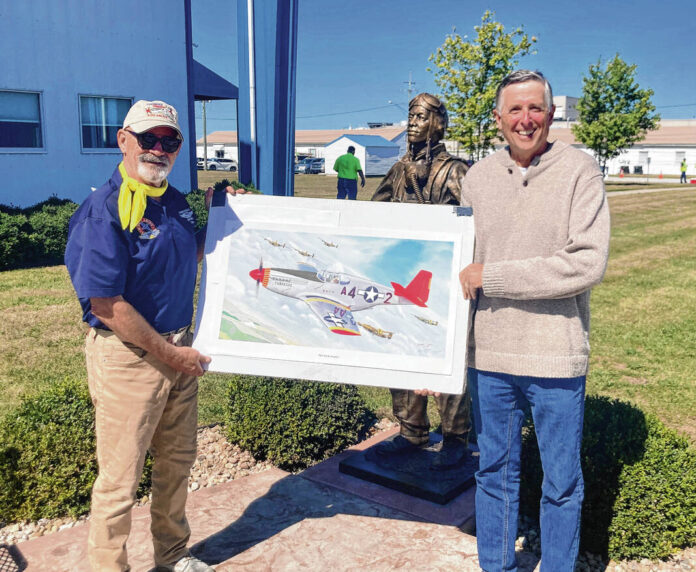
Don Larson, left, of the nonprofit organization Rise Above presents Tuskegee Airmen Freeman Field Mutiny Dedication Week organizer Tim Molinari with an artist print of a P-51 Mustang Red Tail Tuskegee fighter aircraft.
Mitchell Banks | The Tribune
An organizer of the Tuskegee Airmen Freeman Field Mutiny Dedication Week was presented with a gift to commemorate his work in bringing the event to life.
Tim Molinari of Seymour received an artist print of a painting called “Red Tail by Request.” Painted by Sam Lyons, it depicts a P-51 Mustang Red Tail Tuskegee fighter aircraft among B-24 bombers during a World War II mission.
The print was given to Molinari by Rise Above, a nonprofit organization that provided the Rise Above exhibit at Freeman Municipal Airport in Seymour last week for local students and citizens.
Two different short films were shown in a trailer from Rise Above with an extra-wide movie screen. One was about the Tuskegee Airmen, and the other was about Women Airforce Service Pilots.
A dedication ceremony for the Tuskegee Airmen Memorial Plaza at the Seymour airport was held Saturday. Statues of two Tuskegee Airmen, built by Utah company Big Statues, were the primary focus of the ceremony.
In the week leading up to the ceremony, guest speakers talked about the famed Tuskegee Airmen and the new statues. A concert also was held Friday night at Crossroads Community Park in Seymour.
The journey to bring the statues to Freeman Field started in 2015 when Tim Molinari’s son, also named Tim, created a memorial plaza to pay tribute to the Tuskegee Airmen for an Eagle Scout project.
Since the plaza’s creation, the Molinaris raised funds to erect the statues, and they were installed Sept. 26.
Molinari said he was grateful that the dedication ceremony was happening because it had been delayed by his son going to college, some injuries he sustained after falling out of a tree and a global pandemic.
He said he reached out to Big Statues to see if it had any statues in Indiana and learned there were some at the Auburn Cord Duesenberg Automobile Museum in Auburn.
Molinari and his son took a trip to Auburn and said they were impressed with amount of detail in the statues they saw.
“We went up there and looked around and we thought, ‘Wow! They show buttons, creases in pants, zippers and all of this different type of stuff,’” he said.
The facial expressions of the statues were another important aspect of their features, Molinari said, because an original Tuskegee Airman gave feedback that he would like to see statues that were upbeat, positive and forward-thinking.
One statue was to represent “honorable service to the nation,” and the other represented “the defense of our nation,” Molinari said.
The uniforms of the soldier statues were based off of pictures of different Army uniforms and flight suits at the Freeman Army Airfield Museum that Molinari sent to the sculptor and eventually sketched out for the design.
“We really just tried our best we could to get it right and not have the statues represent a single person,” Molinari said.
